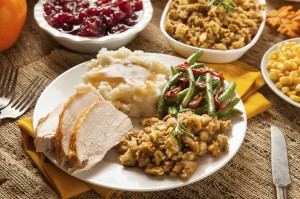
Ahh, Thanksgiving. That time when people celebrate all for which they’re thankful by eating, well, everything. The average American consumes more than 4,500 calories in that single, glorious, gluttonous meal. If that number is shocking, here are some tips to avoid buying larger pants on Black Friday.
On WedMD, former president of the American Dietetic Association Connie Diekman suggests creating a calorie deficit by exercising to burn off extra calories before indulging. And while it seems logical to save up calories for the big meal, experts say eating a small meal in the morning can give people more control over their appetites. It’s best to start the day with a small breakfast so more control can be exercised come the big dinner.
Turkey
Turkey makes people sleepy, right? Everyone knows this. Turns out the amino acid people talk about, tryptophan, is not as special as previously thought. The theory is that tryptophan is ultimately converted into melatonin, which affects the body’s sleep cycles, according to LifeScience. But other foods, including cheese and eggs, contain just as much, if not more, tryptophan. Its potency has perhaps been exaggerated. The more likely explanation for the sleepiness is the amount of carbs consumed at Thanksgiving dinner.
Potatoes
In a straight-up nutritional face-off, Health.com reports that sweet potatoes would win over their white counterparts. Having about the same number of calories, sweet potatoes have more fiber and vitamins A and C. But preparation matters: two scoops of sugary, candied sweet potatoes are not healthier than a plain, baked white potato. Normal potatoes, if not slathered in butter, have their own health benefits.
Dark meat
It’s been reported that dark meat is not as healthy as white meat, and people mournfully pass up the turkey drumsticks in the name of “nutrition.” While it’s technically true that white turkey meat without the skin is the healthier option, dark meat isn’t necessarily unhealthy. A fact check reveals that the difference in calorie and fat count isn’t significant, and dark meat contains more of certain nutrients than white meat, including iron and zinc.
Cranberry sauce
Cranberries are touted (and rightly so) as being a healthy berry, packed with antioxidants and other nutritional value. But being jellied into a sauce with sugar and eating them just once a year is not really enough to get any of the benefits. So although cranberry sauce is yummy and its origins are healthy, don’t go thinking it’s the healthy part of a Thanksgiving meal.
Pecan pie
What’s Thanksgiving Dinner without pie, or multiple pies? When trying to decide which pie to go for, don’t be fooled by the fact that pecan pie has pecans. Nutrition Data reports that while pecans are high in 19 vitamins and a good source of healthy fats and fiber, mixing them into a pie that’s high in sugar, butter and refined carbohydrates makes for a piece of pie with as many calories as a typical meal (more than 500). Compare that with 316 calories for pumpkin pie and 411 calories for apple pie.
Once the dinner is over, Department Chair for the dietetics, food science and nutrition department Michael Dunn has a couple of suggestions.
“The biggest Thanksgiving worry for me as a food scientist is food safety relating to leftovers,” Dunn wrote. “A typical practice is for families to eat a big meal and then retire … before taking care of the dishes and the food on the table. Perishable (high-moisture) foods should be refrigerated promptly, and ideally large amounts of hot food should be broken down into smaller containers to allow them to cool more rapidly. This will prevent bacteria.”
Before, during and after, there are steps to take to ensure Thanksgiving Dinner is healthy.




